Space City Begins
Elhuyar Fundazioa
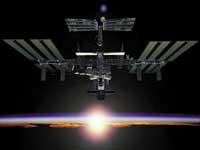
The International Space Station is the largest scientific program developed in collaboration. Sixteen states (USA, Canada, Japan, Russia, Italy, Denmark, Norway, Belgium, the Netherlands, France, Spain, Germany, Sweden, Switzerland, the United Kingdom and Brazil) participate in the 2004-2005 campaign with the aim of having a terrestrial space station of 335-460 kilometers, 108 meters long, 74 meters wide and 460 tons. In it, between 6 and 7 people can live simultaneously in 1,300 m3 pressurized, including the 6 laboratories. The station, which at a speed of 28,000 km/h will constitute an important center of science and research, returned every 90 minutes around the Earth. About 100,000 people will participate in the construction of the station, both in space agencies and in laboratories or contracted companies.
Origin
Going back in history, it can be said that the station was born in 1984 when US President Ronald Reagan officially promoted the construction of a livable space station. It was then named Space Station Freedom. In September 1988 the European Space Agency (ESA) and the Canadian Space Agency (CSA), on the one hand, and in March 1989 the Japanese government, on the other, joined the project responding to the invitation of the US.
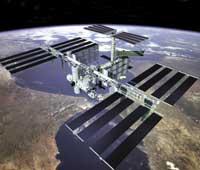
Subsequently, for budgetary reasons, the project was reviewed and the final objectives were reduced through the approval of the alternative called Alfa. Henceforth, the project called Alfa International Space Station maintained about 75% of the structure and systems of the previous one, maintained international participation and the design adapted to budget restrictions. On the other hand, in October 1992 the Republic of Russia was incorporated into the project, which from then on changed its name and became known as the International Space Station. The project has a minimum budget of $40 billion (5.8 billion pesetas/232,000 pounds), although some point out that the real will be much greater.
International
All these changes in the initial project, and especially international participation, have been of great importance to the extent that each State will have its role in the project. The United States is the main responsible and the main weight, but the rest of the members will do important jobs. The ESA will build the pressurized laboratory called Columbus (COF) and an automatic vehicle that does not need a driver to send supplies to the space station, called Automatic Transfer Vehicle (ATV), which will be sent to space in the launcher Ariane 5, to which ESA will allocate a total of 2,705 million euros.
Canada will build a remote control mechanical arm that will be used to integrate the parts needed to complete the station, a $720 million project. Japan will perform one of six pressurized modules to be used for scientific experiments. Finally, Russia will have a great participation. It will offer its experience in long-term stays in the space and the technology used in its stations. Its own launchers will be used to space the different parts of the station and, in addition to its laboratory, will build a service module.
Project steps

When it was decided to design and execute the project in its entirety, three phases were differentiated. The first phase began in February 1994 and has lasted until June 1988: US astronauts made stays at the Mir space station, Russian astronauts traveled on the US shuttle. and, again and again, they made the link between the American ferry and Mir to get the experience and reduce the risks in the encounters of the different sections of the International Space Station.
In the second phase the construction of the station has begun with the two sections sent in November and December 1998. In July of this year will be sent the Service Module built by the Russians with living room, bedroom, toilet, kitchen and other necessary services to be able to reside in the station and the first crew will arrive at the station in January of the year 2000.In the final phase, the building will be equipped with the necessary infrastructure for continuous human life and the rest of equipment and laboratories will be added. In order to accomplish all this, astronauts must make 45 trips from Earth to space and work more than 550 hours outside the ship.
Objectives
The general objectives of this project are several:
- Offer research laboratories in almost ingravitated medium (10,000 times less than on Earth) and in different areas of biology.
- Medical research in space.
- Develop new materials and processes in collaboration with the industry.
- Accelerate technological and engineering advances that impact the Earth in the short term and offer new jobs and economic opportunities.
- Increase cooperation among the States of the world.
In addition to these general objectives, it is clear that the main promoters – and payers – of the ISS, United States, through this program, aim to maintain their leadership "both on Earth and in Heaven", as well as support and improve aerospace technology, the main export sector of their industry.
It can also be said to be an economic goal in the medium and long term. Each dollar invested in space programs generates, directly or indirectly, a profit of two dollars.
Work programmes
Within the previous general objectives, NASA has defined a series of programs and projects to be developed at the ISS. On the one hand, they have developed a project on biology, called Human Research and Spatial Development Project (HEDS). Main objectives of: 1) to increase our knowledge of natural processes through the space environment; 2) to investigate the solar system and 3) to make space travel habitual. To carry out the project, two programs will be launched. The first, called the Biomedical Research and Remediation Program, will be dedicated to human research.

On the one hand, it is about knowing the relationships between physiological and behavioral responses, causing biological changes in humans during space flights; on the other hand, it is intended that the human being live and work in space for more than a year, but achieving that the readaptation to the Earth is not hard and developing protective measures to increase the welfare and safety of the crews. The second, called the Biology and Gravitational Ecology Program, aims to use different levels of gravity to deepen basic knowledge of biological sciences. To do this, they will investigate the influence of gravity on evolution, development, morphology, etc.
On the other hand, the program called Functions Aimed at Planet Earth aims to analyze the quality of the terrestrial atmosphere, water, climate change, vegetation and land use, mineral and food resources and the state of health of freshwater and seas, whose influence on the quality of life is evident.
Third, the Space Science Program aims to solve the mysteries of the universe, study the solar system, discover planets around other stars and find life off Earth. To do this they will work around four main axes: 1) the structure and evolution of the universe; 2) the study of the solar system; 3) the Sun/Earth relationship; and 4) astronomical research on the planetary system and its origin.
The fourth research group is related to microgravity. The gravity force that the station will bear will be one million that we have on Earth, so tests that prevent gravity on Earth, such as biotechnology, combustion, fluid physics, basic physics and materials science, can be carried out. Biotechnology will mainly investigate the growth of protein crystals, essential to understand the structure and functions of proteins, as well as the growth of cells and tissues for use in vaccines and interventions. As for combustion, its importance in today's society is evident, but nevertheless, the information we have about combustion is very limited. His experiments in space aim to fill that void.
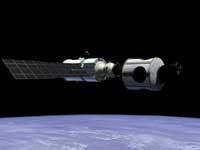
His research on fluid physics, especially in building safety, energy transformation facilities and predicting the behavior of materials on the Moon. In the field of basic physics they will work with theories not likely on Earth. Finally, in the field of materials science, the structure of materials (atomic and/or molecular level), properties (thermal, magnetic, chemical, etc.) Creation (how they behave in their origin) will be analyzed in order to apply the results to Earth.
The fifth, called Engineering Research and Technology Project (ERT), is aimed at developing and experimenting technology, which will later be used to improve vehicle transport systems and capacities, reduce maintenance and repair costs and reduce fuel and crew in space. Therefore, technology would be developed both in space and on Earth.
Finally, NASA's Office of Life and Microgravity Sciences and Applications (OLMSA) program organized the Comertial Space Centers (CSC's) to promote private industry space research. Companies and associations that have participated so far have conducted research in all areas (biology, biotechnology, combustion, electronics, communications, materials, agriculture, robotics, medicine, food...) and are now preparing to participate in the ISS.
Right of use and option
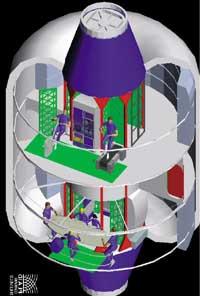
All these programs are created by NASA itself, so they will be developed mainly in US research modules. However, at the International Space Station, Europe (through ESA) and Japan will also have their research modules and have the distribution agreed for common use. The US will be able to use 97% of its laboratories and 46% of the European laboratory COF and Japanese JEM. However, Canadians will be able to use 2.3% of the entire research infrastructure in exchange for the construction of the external robot and Russians will operate on their own. The ESA COF module will investigate, among other things, cell growth, plant production and the influence of radiation on human tissues. They will also analyze the sun, the cosmic background, the activity of fires and volcanoes on Earth and the behavior of different materials in open space.
Private companies will also be able to investigate, specifically between 20 and 30% of the European infrastructure and between 30 and 40% of the United States, although those responsible for NASA would want this percentage to rise to 60%.
Not everything is pink
Although the expectations created and the possibilities of research are undeniable by the project promoters, there are differences between scientists. The main reason used by critics is the lack of the project. According to them, NASA is getting behind other projects the amount of money it needs for the station and many of the goals it wants to achieve with the orbit of astronauts, on the one hand, with the use of robots and, therefore, with less money spent, can be achieved and on the other hand, some of these studies can also be done on Earth. In addition to the costs, many of the investigations that will be carried out in space denounce that, more than for use on Earth, the human being will adapt more comfortably to the space and question its usefulness. Moreover, it seems that the vibrations of the space station can affect numerous studies; in the tests carried out the vibration damping systems did not work properly and it seems that they will not be tested again until they are used in space.
In addition, NASA officials have recognized that the risk of a serious accident is significant (73% of the possibility of serious problems during assembly) and that a death accident occurs.
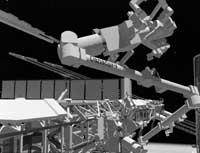
In fact, despite the importance of the experience gained with Mir, they are new tools and software that are being used on the ISS and that have not tested on Earth all the components of the station.
It seems that the project promoters look mainly at Mars and the Moon and see the space station as an intermediate step to make the leap to them, as the station will serve to learn how to live in space for a long time, how to produce food and how to recycle water and air.
Participation of a Basque companyThe Inasmet technology center, located in Donostia-San Sebastian, in collaboration with the National Institute of Aerospace Techniques (INTA), prepares one of the experiments to be carried out at the ISS. Within the experiment called "Tribolab", in 2001 a sophisticated bearing system will be installed outside the ISS to analyze the behavior of lubricants in spatial conditions. In addition, its response will be analyzed in other situations such as radiation, vacuum and atomic oxygen. The lubricants of the known cars evaporate in space, since twice a day the temperature varies between 100 and -100 ° C, so in spacecraft and stations only solid lubricants can be used. The goal is to improve the products used so far. Moreover, INASMET will also manufacture specific materials for European Space Agency laboratory refrigerators at the space station. In these refrigerators biological research carried out on the ISS will be kept and will last for twelve years, not replacing them during all that time. |





